#1695 fashion
Explore tagged Tumblr posts
Text

submitted by @shilohta 💚💙
#historical fashion poll submission#very historical historical fashion polls#historical fashion polls#fashion poll#historical dress#historical fashion#dress history#fashion history#fashion plate#17th century#17th century fashion#17th century dress#1690s#1694#1695#skirt
72 notes
·
View notes
Text
Try again (Toshinori Yagi Smut)

Requested: no
Summary: You want to add another addition to the family, he’s unsure.
Word Count: 1695
Warning(s): Self-doubt, Smut
“So What I think doesn’t matter?” You question sitting down next to Yagi on the couch.
Tho you’d been with him for years and have 2 kids, he still occasionally gets into these strange thought patterns. Yes, his self esteem has been low ever since he lost use of his All Might form, but you thought that you having been with him for so long would be worth something.
“Of course it does, dear!” His eyes shoot towards yours, as if searching for something.
“Well then, listen to me, I married you because I love you, all of you. Furthermore I prefer you in your smaller form and I’ve told you as much as thousand times. I know it’s not easy, and I know you feel down, but you need to remember that people still love you no matter what!” You say, taking a sip of your tea, offering Toshi his own cup. He takes it, looking like he’s deep in thought.
“You’re right” he says looking at you again with a smile, but it seemed a bit hollow, like he didn’t truly believe it. You decided to not push the matter further for now as your 9 year old barges into the living room from his room. “ Dad! Look” he says excitedly, he had fashioned his blanket into a cape. You smile wiggling your eyebrows at your husband.
He goes to play with him and your 6 year old joins in, playing as a villain.
You thought the ruckus in your house would never stop as your family spent their day off playing heroes and villains and god whatever else came to their creative brilliant little minds. Your husband played along with all of it.
By the end of the night, the kids were so worn out, getting them to bed was a dream. They were sleeping pretty much the second their heads hit the pillow.
You were in your bedroom, getting ready for bed as Yagi joined you. “Hey, I wanna talk to you about something when you have a moment.” You tell your loving husband as you put on your baggy sleep shirt. “What’s on your mind, darling?” He inquired.
“ I want another kid.” You blurt out, looking away, worried about his reaction. A breath hitches in his throat causing him to cough. “Y/n, Im not sure that would be a good idea, the kids would have a pretty big age gap and I don’t know if I could keep up with another kid…” he says, nudging you to face him, putting a finger under your chin to lift it, getting you to look at him.
“I know… but I miss being pregnant” you trail off. “Why would you want another child with someone like me? When we had our boys I was still All might, I still had something to offer.” He confesses quietly. Doubts swirling in his mind. It was true, you had your youngest long before his quirk became nearly un usable. It always worried him, not being able to protect his family anymore, he also thought you would lose your interest in him. To his surprise you had stayed steadfast in your love and adoration for him.
You shoot him a glare, “I love you no matter what Toshi, You have so much more to offer than just being a hero and I still don’t care what form you’re in.” You tell him, giving him a reassuring peck. In all honesty, if you had the time and he had the energy, you’d have a gaggle of kids by now. You’d be jumping his bones at every and any opportunity. Sadly tho, with your family keeping both of you busy and his injuries hindering his sex drive, that hasn’t been a possibility.
“I don’t know” he says nervously. “Just think about it, even if the answer is no, I would appreciate you giving it a thought.” You tell him, looking at him with a slightly sad look. He caught it immediately but didn’t say anything about it, giving you a nod.
Getting in bed, you fall asleep tho a little restless, he on the other hand couldn’t sleep. Toshis thoughts were racing.
He wanted to give you want you want. He always had. But at the same time he was unsure if he could handle another kid. Yagi loves his boys and would do anything in his power for them. Could he have another?
Before he knew it, the blaring alarm, rays of sunshine and tussling from your side of the bed awoken him from a slumber he didn’t even realise he was in. He keeps his eyes shut, trying to get a little more sleep while you get out of bed and make your way to the kitchen.
Cheerful giggles fill your home and delightful smells of food tingle the nose. Toshi shuffles towards the kitchen, stopping when he sees you three. Playfully preparing breakfast. The youngest is holding the spatula, while the oldest is getting things out of the fridge to set on the table. You’re cutting up fruit as you giggle at your youngest making goofy faces.
They look so much like a younger version of their father. You always wonder where your genetics disappeared to.
The breakfast was delicious, even if Toshi couldn’t eat a whole lot and everyone was all giggles. Today was the end of the weekend, meaning the boys needed to clean up their rooms and do all their homework. And man does Yagi find it sexy when you go into teacher mode. You run a tight ship. The boys already know the routine.
Your husband’s heart flutters as he watches you help your oldest do his math as the youngest also listens tho he clearly doesn’t fully understand what you’re going on about. Maybe he truly does want another kid.
Getting back to the bedroom, the boys clean and in bed, getting ready to go to sleep yourself. Toshi comes out from the shower a beautiful wide sparkling smile on his face. “I think I’m okay with trying for another.”
“What?” You question, what he said not quite registering. “ I want another baby, unless you’ve changed your mind, dear” He explains, his smile slightly faltering. “Really?!” You whisper shriek. He nods, his smile even brighter than before, you swear that smile could make you melt if you looked at it long enough.
You smash your lips into his, pulling him into a passionate kiss as you pull him closer by the drawstrings on his pj pants. “Are you sure?” You say catching your breath. “Yes.” He chuckles. As you make your way towards your bed.
He gently pulls the shirt you just put on over your head, throwing it on the ground together with his pj pants. He’s already starting to pitch a tent in his underwear. He’s gently kissing down your neck as you gently play with his hair. He reaches your breasts, gently nuzzling one as he squeezes the other, a gentle hum escaping you.
“You’re so beautiful, y/n” he says, taking one of your nipples in his mouth. He gently suckles on in, soon switching to the other. “ I wish we had time to do this more often” you murmur. He chuckles lowly, kissing down your abdomen, getting closer and closer to your core.
He gently nibbles on the soft supple skin of your inner thigh, earning a slight arch of the back from you.
He gently removes your panties, rubbing a finger in your folds. Soon his tongue follows. He’s eating you out like it’s his last supper, earning moans and groans from you, your hand stuck in his hair unable to contain your pleasure. You can feel a mile on his face as he gets you this riled up. He knows he can’t last as long as he used to, so he makes sure you feel as good as possible before the main act.
Euphoria hits you as your muscles clench, begging for a release. His tongue hits your clit perfectly, throwing you off of the cliff, bliss clouding your mind.
“ I need you” you moan, as Toshi gets back on top of you while you try to push his underwear off. He assists you revealing his massive member. Even after all these years, you’ve still never quite gotten used to it. Didn’t help that he was gone so often. “ I love you, y/n” he tells you as he’s lining himself up, giving you a deep, passionate kiss. It feels like he needs you, in a way that could never be described. It’s so loving yet needy.
“ Are you ready, sweetie?” He groans. “Yeah” you moan in anticipation. He gently pushes into you, giving you a bit of time to adjust. You roll your hips into him, signalling for him to move.
The thrusts are slow, deep and sweet. He’s making love to you like it’s the first time, no matter how many times you’ve been in this situation. He’s always just so sweet and caring. His hips roll into yours so naturally, like you’re made for each other. Youre both trying to keep it down, but it feels so good that some quiet groans escape both of you. Yagis pace quickening as his climax is getting closer.
You pull him closer, your nails gently grazing his back. He’s kissing your neck, sucking on the skin here and there but not hard enough to leave marks. Your becoming more and more breathless as you get closer to your second cumming.
His thrusts become jagged and less rhythmic as you feel him twitch in you. A few more thrusts later, you climax again, him following shortly after. He stays inside as his seed shoots into you, his breaths short and body being held up by just his elbows. Yagi shoots you a bright smile, kissing your cheek. “Hopefully that did the trick” he chuckles, slowly pulling out and laying down next to you.
“I wouldn’t mind doing that again,” you beam, sending him a wink, a deep blush gracing his cheeks.
“I love you, y/n”
“I love you too, Toshi”
Masterlist
Ask
With love,
-K
#mha fanfic#yagi toshinori#toshinori yagi x reader#all might x reader#all might smut#my hero academia fanfic#mha smut#bnha toshinori#bnha fanfiction#bnha x reader
731 notes
·
View notes
Text
What are Campanes ?

In part V of my article on the bedchamber I mentioned campane ornaments several time, without ever explaining what they are, in this post i will take the time to clarify that relatively obscure yet very popular type of ornamentation.
Campane ornaments, characterized by their distinctive bell-like shapes with tassels, are decorative motifs that bring rhythm and elegance to architectural and interior designs. These ornaments, typically arranged in repeating patterns along the edges of canopies, cornices, and valences, resemble stylized bells suspended in a linear formation. Their formal beauty made them a popular decorative choice across Europe, particularly in France, where they became symbols of opulence and grandeur during the reign of Louis XIV.
The origins of campane motifs can be traced at least to the 16th-century in Flemish Renaissance art, where early forms of these bell-shaped ornaments began appearing as decorative borders of canopies(fig 1).

Fig 1 : "Ester e Assuero," 16th-century Mannerist painter from Antwerp, oil on panel, 99 x 136.5 cm, Zambeccari Collection, Inventory No. 204, Pinacoteca Nazionale di Bologna
At the same period they can be seen in certain fashion ornaments, for instance around the knee of some of the heroic armours, designed to be references for the brass statues representing Emperor Maximilian's ancestors guarding his tomb (fig 2)

Fig 2 :Kölderer’s drawing from 152211 (Wien, Österreichische Nationalbibliothek, Cod. 8329, fol. 15)
By the second half of the 17th century, campane ornaments had spread widely across Europe, reaching peak popularity and becoming synonymous with Baroque decor. France embraced campane motifs with particular enthusiasm. They became integral to the decorative vocabulary of the French court and the broader Louis XIV aesthetic. In fact, the motifs became so prevalent that Swedish diplomat Daniel Cronström who was in France at the time wrote to Swedish royal architect Nicodemus Tessin in 1695, observing :
"The campane ornaments, made and trimmed, are now so much in fashion that one sees almost nothing else [Les campanes faites et gallonées sont maintenant si fort à la mode qu’on ne voit quasi que cela.]"
— Daniel Cronström to Nicodemus Tessin, January 7, 1695
Applications in French and European Decor
Architectural and Decorative Applications
Campane ornaments quickly became a feature in grand architectural settings, with Versailles as a prime example. On the cour de marbre façade of the palace, the upper cornice is lined with a continuous row of gilded campane motifs, creating a rhythmic elegance to the roofline and enhancing the palace’s imposing silhouette (fig. 3 and 4).

Fig 3 :Élévation de la façade nord sur la cour de Marbre et sur la Cour royale. Coupe sur la partie médiane, after 1682 AN O/1/1768/A, dossier 1, n°1

Fig 4 : Palace of Versailles drone view of the roofs on the cour de marbre facade.
They were also used in architectural interiors, where they added a rhythmic and opulent touch to cornices and molding. At the Hôtel de Chevreuse recreated in the Louvre (fig. 5), the campane motifs line the upper edge of the room’s panels, creating a visual continuity that highlights the room’s refinement, and seperation between the space of the alcove and te rest of the room.
In the King’s bedchamber at Versailles, campane ornaments also appear on the cornice that divides the room from its open attic (Fig. 6). Here, individual campane pieces punctuate the cornice, reinforcing the room’s formal symmetry and creating a unified aesthetic with the bed canopy below. This architectural application of campane motifs enhances the decorative richness of the space and underscores the room’s ceremonial significance, where every detail contributes to the regal atmosphere.

Fig 5 : Salle 622, Louvre Museum, originally the Parade Bedchamber of the Hôtel de Chevreuse.

Fig 6: detail of the cornice of the central salon in Versailles, who became the King's Grand Bedchamber in 1701.
Furniture and Coaches
Beyond architecture, campane ornaments adorned ceremonial furniture and royal coaches, reinforcing their association with prestige and authority. In Entrée à Arras by Adam-Frans van der Meulen (fig. 7), the canopy of Louis XIV’s royal coach is lined with campane valences, demonstrating how these ornaments were used to convey regal dignity even in mobile spaces.

Fig 7 :Detail of Entrée à Arras de Louis XIV et de Marie-Thérèse, 27 juillet 1667," Adam-Frans Van der Meulen, oil on canvas, 1680-1685, 232 x 331 cm, Château de Versailles, MV 6057
Printed Works
The influence of campane ornaments extended into printed works as well. In the 1669 engraving L'audience royale donnée aux nations étrangères by Nicolas I de Larmessin (fig. 8), campane motifs frame key elements around Louis XIV, emphasizing the structured hierarchy and formality of the French court. This engraving shows how campane ornaments permeated different artistic mediums, symbolizing authority in both the real and the representational worlds.

Fig 8 :L'audience royale donnée aux nations étrangères, almanach 1669," Nicolas I de Larmessin, engraving, edited by Pierre Bertrand, 1669, Musée du Louvre, Paris.
Adoption Across Europe: Sweden and Germany
The popularity of campane ornaments wasn’t confined to France; they became fashionable across Europe, especially among designers who admired the grandeur of French decor. For example, Daniel Cronström and Nicodemus Tessin, influential Swedish designers, corresponded extensively about incorporating French styles into Swedish architecture. Cronström’s aforementioned letter reflects this enthusiasm, showing that campane ornaments were a pan-European trend embraced by Francophile designers.
In Germany, campane ornaments also found a place in the Margravial Opera House in Bayreuth, where a grandcanopy is adorned with these motifs (Fig. 9). This example demonstrates the cross-cultural appeal of campane ornaments.

Fig 9 : Detail of the canopy at Margravial Opera House in Bayreuth
Campane Valences on Royal Beds
The ultimate prestige of campane ornaments lies in their use as valences on royal beds, transforming these canopies into symbols of authority and ceremony. In Louis XIV's France, royal beds were not merely functional pieces but ceremonial centers where kings and queens held court, making them a focal point of royal power.
Examples in Royal Bedchambers
Campane valences on royal beds can be seen in early examples, such as Louis XIV’s bed at Trianon (circa 1700, Fig. 10) and his bedchamber at Marly (1692, Fig. 11). These valences framed the bed, accentuating its importance and creating a sense of regality around the sleeping area. The presence of campane ornaments on these beds marked them as spaces of prestige, emphasizing the central role of the monarch’s bedchamber in court life.

Fig 10 :BnF, Dept. Est. FOL-VA-78 (G, 2)

Fig 11 :BnF, Dep. Est. RESERVE HA-18 (40)-FOL
The 1701 King’s Bedchamber at Versailles
One of the most iconic uses of campane valences on a royal bed is found in the 1701 bedchamber at Versailles (fig. 12, 13 and 14). Here, the bed’s canopy was adorned with an intricate campane valence, framing the area where Louis XIV conducted his lever and coucher ceremonies. These daily rituals, in which courtiers observed the king’s rising and retiring, were significant court events. The campane valences on this bed reinforced the ceremonial function of the space, creating a structured grandeur around the king and emphasizing his authority.

Fig 12 : Drawing of the King's bedchamber(Louis XIV) in Versailles(after 1701) National Museum, Stockholm, NMH CC 174

Fig 13 :François Marot, "Institution de l'ordre militaire de Saint-Louis, 10 mai 1695," 1710, oil on canvas, Château de Versailles, Inventory No. MV 2149.

Fig 14 : Mention of the campane valences in the description of set 1881 present since 1701 in the King's grand bedchamber AN O1 3446 fº 381 vº
Transition to Festoons in the 18th Century
By the end of Louis XIV's reign, changing tastes led to the gradual replacement of campane valences with festoon-shaped valences, as seen in the 1714 bedchamber at Fontainebleau (Fig. 15). This shift reflected the emergence of the Rococo style’s preference for softer, more organic forms. Although campane ornaments were no longer in fashion, their legacy as symbols of royal power and opulence remained.

Fig 15 : Louis XIV reçoit à Fontainebleau le prince-électeur de Saxe, 27 septembre 1714, Louis de Silvestre and Hyacinthe Rigaud, oil on canvas, 1715, 120 x 155 cm, Château de Versailles, MV 4344
29 notes
·
View notes
Text
Making late Medieval Fringe
Fringe was an important part of 16th and 17th century Irish fashion. In this post, I will discuss the historical evidence for its use and my attempt to reconstruct it.
Fringe shows up on Irish garments in several period works of art.
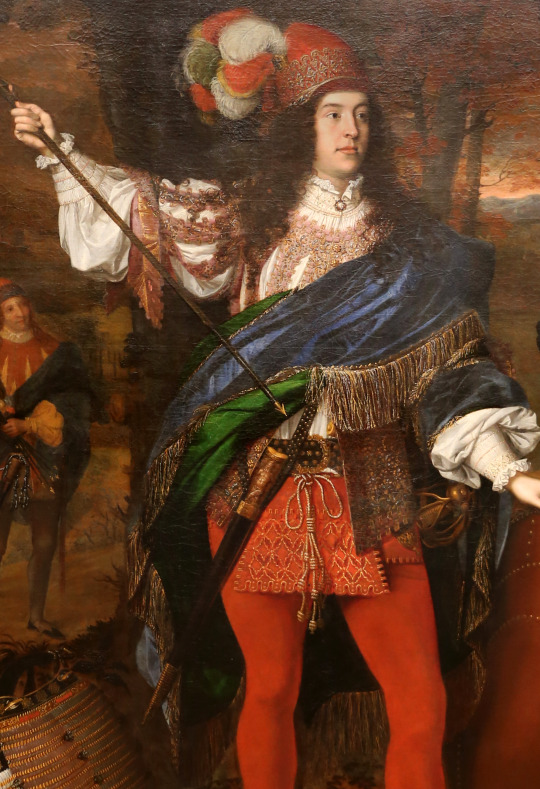
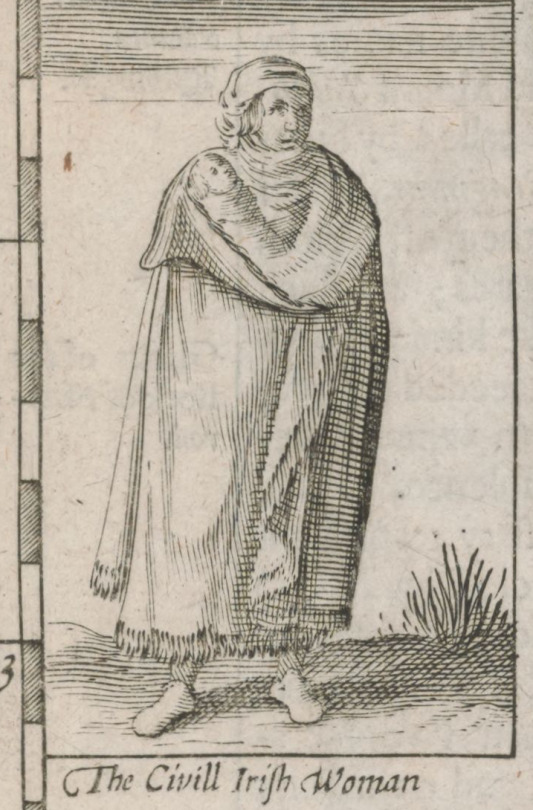
1680 Portrait of Sir Neil O'Neill by John Michael Wright and the 'Civill' Irish Woman from John Speed's 1611 map of Ireland, both shown wearing a fringed brat (Irish mantle).
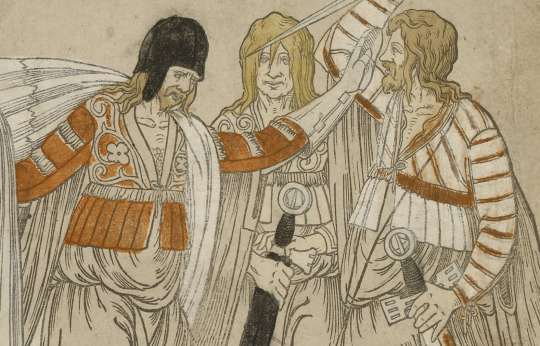
Detail from 'Drawn after the Quicke', an anonymous 16th c. English print showing Irish men wearing ionair (Irish short coats) embellished with fringe.
Historical Research:
The Irish use of fringe is mentioned by several period writers. In 1548, Paolo Giovio stated that most Irish men wore, "a soldier’s woollen cloak, with a fringed and variegated edge for elegance" (translation from Harris 2007). Similarly, William Good said Irish men and women wore "mantles or shag-rugs [. . .] fring'd round the edges with divers well mixt colours" (1586/1695). 17th century writers Luke Gernon (1620) and John Lynch (1661/1850) both described how the Irish continued to wear fringed mantles in spite of British colonial laws banning them. Gernon stated that the Irish mantle (ie brat) "differs nothing from a long cloke, but in the fringe at the upper end, which in could weather they [the Irish] weare over their heades for warmth," suggesting that this use of fringe was such an important part of Irish fashion that it was a marker of cultural identity.
This fringe appears to have been a separate trim, typically made of wool or silk, that was added to the garments. This is suggested by John Speed's description of Irish mantles as being "purfled with a deepe Fringe of divers colours" (1611). Applied fringe trim can be seen on the brat in Sir Neil O'Neill's portrait. In his poem "A Vision", 16th c. Irish poet Tadhg Dall Ó hUiginn describes a fairy woman wearing, "A purple mantle with satin fringes" (1550-1591/1921). Fringes made of silk and wool are found among recorded imports to Ireland in the late 16th c. (Flavin 2011).
Despite all this period evidence, I sadly do not know of any extant examples of Irish fringe from this period. Since at least some of the fringe used in Ireland was imported, I decided to look at examples from other parts of Europe to determine how Irish fringe might have been made. Looking at 15th-17th c. examples in the V&A, I saw 2 common manufacturing methods: warp-faced plain weave and tablet weave.
I decided to go with tablet weave for this project, because tablet woven bands have been found at earlier Medieval sites in Ireland (Wincott Heckett 2002). Following the historical costuming advice of The Welsh Viking that simple things less likely to be wrong, I used this simple late-15th c. fringe from Sweden as the basis for my pattern. Simple tablet-woven fringes continued to be used into the late 17th or early 18th century.
I used wool yarn for this project, because I wanted something that could have plausibly been made in Ireland and afforded by Irish commoners, instead of a luxury import like silk. Wool also seemed like the best fit for John Lynch's characterization of the fringe on a brat as a practical feature which protected the wearer's neck from the rain (1661/1850). I chose blue based on a combination of the availability of woad in 16th c. Ireland (Flavin 2011), the noted fondness of the Irish for bright colors (McClintock 1943), and personal preference.
My reconstruction:
I used Garnhuset wool weaving yarn I purchased from Vävstuga Weaving School in size 20/2 for the warp and 28/2 for the weft. (Check out this video, if you need an explanation of how tablet weaving works.) I made a box loom out of a cardboard box, although I suspect that any loom type that works for tablet weaving would also work for this.

Also used bamboo chopsticks, tape to cover the rough edges of the cardboard, and a shoelace. Not pretty or historically accurate, but cheap and easy to make.
My tablet weaving pattern uses 6 cards. Cards 1,3,5 are Z threaded. Cards 2,4,6 are S threaded. All 6 cards are turned in the same direction until too much twist is built up on the warp to continue, all 6 cards are then turned in the opposite direction until too much twist is build up to continue. Reverse direction and repeat until you run out of warp.
For the weft, I used 5 strands the of 28/2 yarn run together as if they were a single weft thread. I placed a rectangle of sturdy cardboard against the left side of the warp and looped the weft around it as I wove. I neglected to get a good picture of this on my actual loom, so here is a picture of my test piece setup.

The relevant part here is the light blue and purple threads. Ignore the shuttle of black thread.
As I advanced the warp, I slid the cardboard rectangle forward to continue weaving. After I took the completed fringe off the loom, I took a pair of scissors and cut the bottoms of the weft loops.
If you try this, I strongly recommend covering the long edges of your cardboard rectangle with tape. This will both protect your warp from being chewed up the cardboard and make the cardboard more slippery and easier to to slide forward. Also, make sure you are beating the shed well and pulling your weft tight. Once you cut the loops, the tightness of your weave is the only thing keeping your fringe from pulling out.
Results:
I whipstitched the completed fringe to the edge of my brat. I am extremely happy with how this turned out. I had never done tablet weaving with wool before, so I had no idea what to expect.

This method creates a thick, fluffy fringe which I think does a nice job recreating the look of "Drawn after the Quicke". You do lose quite a bit of length though. The wool yarn is kind of stretchy, and tablet weave is kind of stretchy (similarly to a twill-weave fabric). Between the ends of the warp lost to setting up the loom, and the stretchiness of the finished product, 11 ft (335 cm) of measured warp gave me 92 in (234 cm) of completed fringe. Oh, well. At least my loom can easily accommodate a longer warp, and this piece only used 20% of my 2 skeins of yarn.
I did also make a test piece out of DMC Pearl cotton. The warp is size 8 embroidery thread, and the weft is size 25 embroidery floss with all 6 strands used together. It is slightly easier to work with than the wool, (wool warps do have an annoying tendency to stick to each other), but I don't like the way it looks as much.
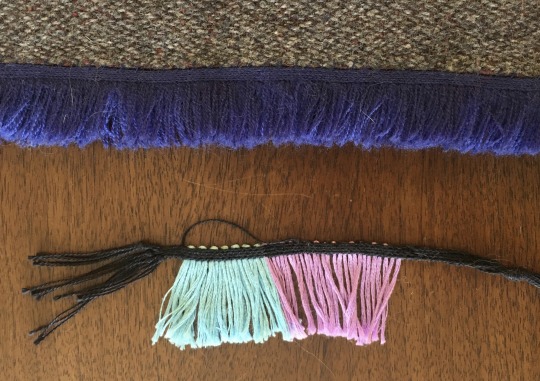
Wool fringe above, cotton below. Ignore the purple fringe. It has an extra weft thread that is not part of the fringe, which is why it looks more gappy than the light blue.
The cotton tends to stay in its discrete clumps rather than feathering out to form a nice fluffy, connected whole like the wool does.
I then went to the Ren Fair and located an appropriate sword.
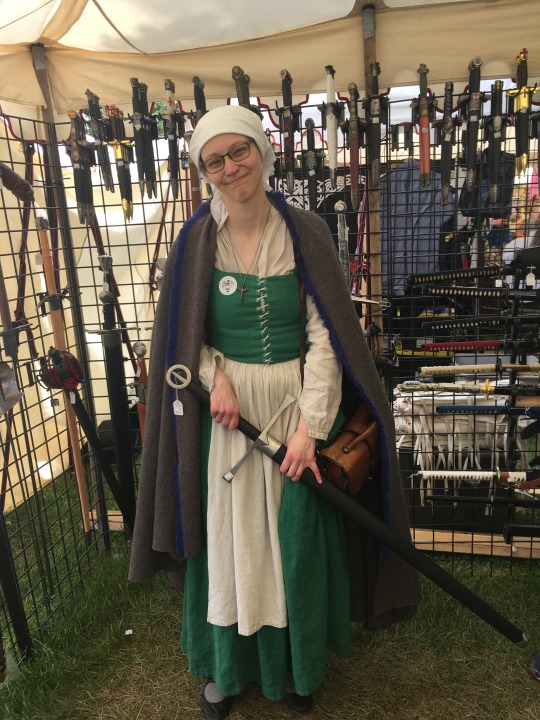
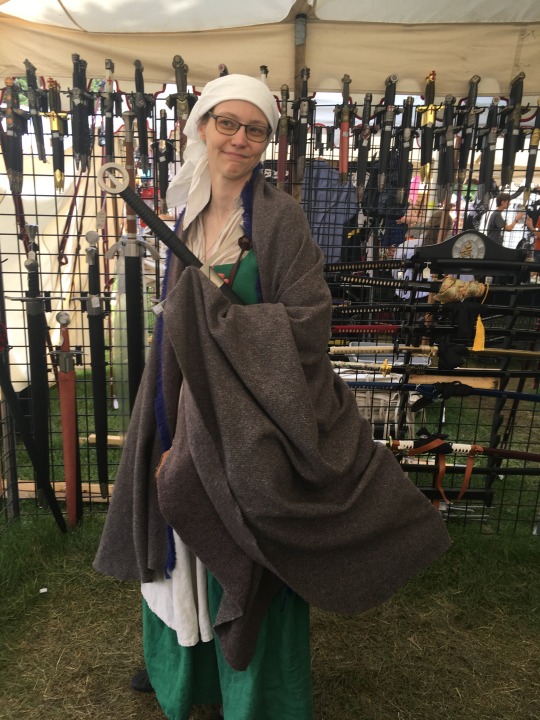
(Yes, that's an English kirtle and smock. I haven't finished making my other Irish garments yet.) Me carrying a sword a la Albrecht Dürer's kern.
I really should have made this fringe longer. It's only 1 in (2.5 cm) long. Looking at the scale of Speed's "Civill" woman, I would estimate that hers is closer to 2 inches long. I may add a longer second layer. John Lynch does say that the brat has a doubled layer of fringe in the neck area (1661/1850). Adding a second color to the weft would probably better match William Good's description of "divers well mixt colours" and Paolo Giovio's "variegated," but I like the way the solid blue looks.
As a bonus, I will say that the wool fringe feels softer and nicer than the cheap coating wool I used to make my brat. I suspect that may be part of the reason the 16th-17th c. Irish were so fond of having thick fringes in the neck area, to protect the skin of their necks from the irritation of a brat made of coarse wool. The léine would have protected most of their body, but it largely left the neck bare.
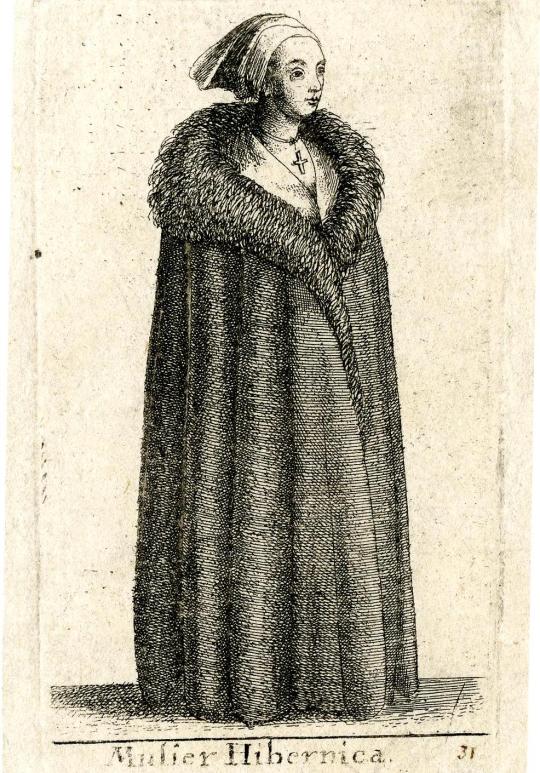
Irish woman wearing a brat with a deep fringe by Wenceslaus Hollar published 1643
Want to give me a tip? Ko-fi page
Bibliography:
Flavin, Susan (2011). Consumption and Material Culture in Sixteenth-Century Ireland. [Doctoral thesis]. University of Bristol.
Gernon, Luke (1620). A Discourse of Ireland. https://celt.ucc.ie/published/E620001/
Good, William (1695). The Ancient and Modern Customs of the Irish. In W. Camden (ed) Camden's Britannia newly translated into English, with large additions and improvements; publish'd by Edmund Gibson (p. 1042-1048) (Edmund Gibson, Trans.). Edmund Gibson. (Original work published 1586) http://name.umdl.umich.edu/B18452.0001.001
Harris, Jason (2007). Ireland in Europe: Paolo Giovio's "Descriptio" (1548). Irish Historical Studies, 35(139), 265-288.
Lynch, John. (1850). Cambrensis Eversus (Matthew Kelly, Trans.). Dublin: The Celtic society. (Original work published 1660) https://archive.org/details/cambrensisevers04kellgoog/page/200/mode/2up
McClintock, H. F. (1943). Old Irish and Highland Dress. Dundalgan Press, Dundalk.
Ó hUiginn, Tadhg Dall (1921). The bardic poems of Tadhg Dall Ó Huiginn (1550–1591) (Eleanor Knott, Trans.). (Original work published 1550-1591) https://celt.ucc.ie/published/T402563/index.html
Speed, John (1611). The Theatre of the Empire of Great Britaine: presenting an exact geography of the kingdomes of England, Scotland, Ireland, and the iles adioyning. William Hall, London.
Wincott Heckett, Elizabeth (2002). Irish Viking Age silks and their place in Hiberno-Norse Society. Textile Society of America Symposium Proceedings, 427. https://digitalcommons.unl.edu/tsaconf/427
#irish dress#16th century#17th century#irish history#historical men's fashion#historical women's fashion#historical costuming#dress history#fringe#irish mantle#bratanna#historical reconstruction
50 notes
·
View notes
Text
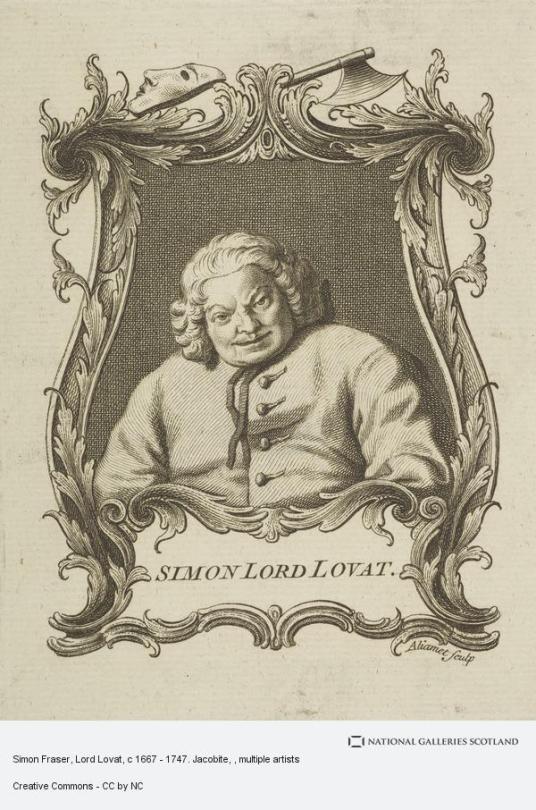
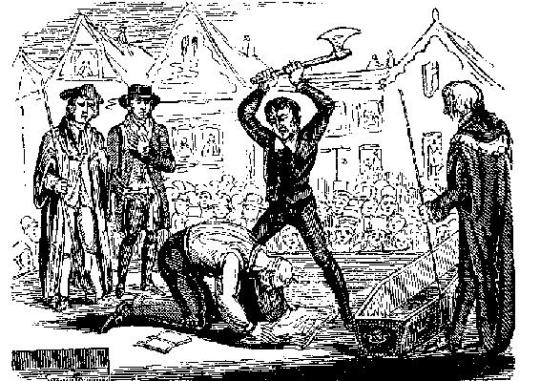
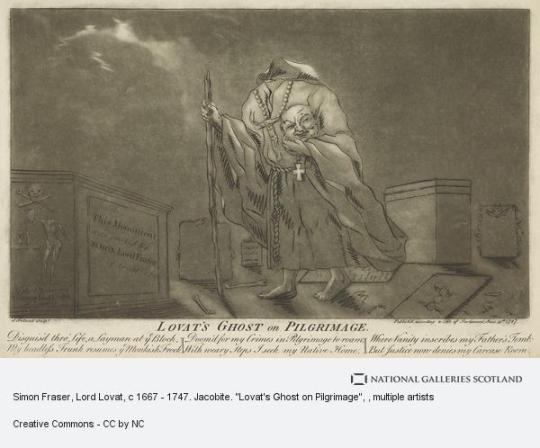
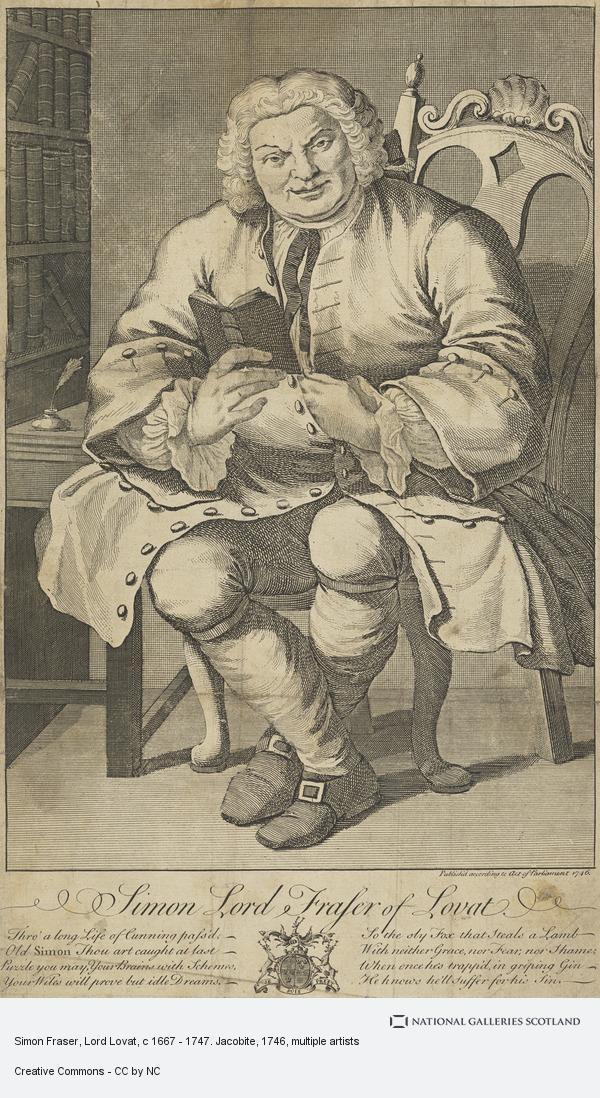
On 9th April 1747 Simon Fraser, Lord Lovat, the leading Scottish Jacobite rebel was beheaded on Tower Green.
A longer post than normal from me as in my opinion Simon Fraser was one of the most interesting characters in Jacobite history. A man of contrary, he was known to be very kind to the lesser clansmen taking a paternal interest in their affairs. A quote regarding him says that….“Generally he had a bag of farthings for when he walked abroad the contents of which he distributed among any beggars whom he met. He would stop a man on the road; inquire how many children he had; offer him sound advice; and promise to redress his grievances if he had any”
In his own estimate, he took care his clansmen were ‘always well-clothed and well-armed, after the Highland fashion, and not to suffer them to wear low-country clothes’ Lovat was also a brute of a man forcing a young woman into marriage and raping her in an attempt to legitimise the union. Lovat has become more well know lately thanks to Outlander, where in their world he is grandfather to the main protagonist Jamie Fraser and played brilliantly by the fine Scottish actor Clive Russell. Back in the real world he has been in the news in the recent past, I shall cover that at the end of this post.
Born in 1667 into the ancient clan who fought with distinction in the Wars of Independence – Sir Simon Fraser was one of the co-victors of the Battle of Roslin and his sons were close friends of Robert the Bruce, Alexander marrying Bruce’s sister Mary – Simon was the second son of Thomas Fraser of Beaufort who was closely related to Lord Hugh Fraser of Lovat, chief of clan Fraser.
Simon became his father’s heir when his elder brother was killed fighting alongside Bonnie Dundee against the forces of King William III at the Battle of Killiecrankie in 1689. He was still nowhere near being clan chief, however, and took himself off to Aberdeen University from which he graduated in 1695. Lord Hugh Fraser, the 9th Lord Lovat, was a weak man who unexpectedly signed over the clan leadership to Simon’s father in 1696.
Lord John Murray, Earl of Tullibardine and the most powerful man in Scotland, disputed the succession and fell out spectacularly with Simon in Edinburgh. The young Fraser hothead duly went north to Castle Dounie to try and persuade Hugh’s widow Amelia to give him the hand of her daughter, also Amelia, in a dynastic marriage that would seal his succession. Tullibardine was having none of it and moved his niece to the Murray stronghold, Blair Castle, where he planned to marry her off to Alexander Fraser, heir to the Lordship of Saltoun.
Simon retaliated by kidnapping Alexander and frightening him away, and to make matters worse in October, 1697, he went back to Castle Dounie and forced the widow Amelia into a sham wedding, raping her to consummate the “marriage”.
Tullibardine ensured Simon and his father were declared outlaws and when old Thomas died in 1699, Simon was unable to legally claim his title as 11th Lord Lovat which later passed to one Alexander Mackenzie who had legally married the younger Amelia.
Simon Fraser somehow managed to persuade King William that he was no threat, despite having his own personal army, and he was pardoned in 1700, only to be declared an outlaw again the following year over the forced marriage and rape.
Simon went off to the court of the Stuarts in France where he devised the plans that were eventually used in the 1715 and 1745 uprisings. Long before the former, however, Simon was double dealing, giving Queen Anne information about the plans of James, the Old Pretender. He was found out and King Louis XIV clapped him in jail for three years.
Even after he was released he was prevented from travelling to Scotland and thus missed the Act of Union which he opposed.
Still desperate to get his Lovat title and the chieftainship of his clan back, Simon sided with the forces of the new King, George I, during the ’15, and was given back his title as a reward, with Alexander Mackenzie imprisoned for being a Jacobite. The two men would fight in the courts for the next 15 years as to who was entitled to the income of the estate. Simon eventually won and spent his time building up the Fraser estates and wealth, even taking command of one of the Independent Companies of Highland soldiers established by the Hanoverian regime – the Fraser Highlanders.
As I said early Fraser was a man of contrary and to me was very like “Bobbing John” The Earl of Mar another Jacobite who a tendency to shift back and forth from faction to faction, no sooner had Fraser built up this “Hanoverian” army that he started openly campaigning for the restoration of the Stuarts. The Government responded by cancelling his military role.
When Bonnie Prince Charles landed in Scotland he was still playing games.
He allowed his sons to fight for the Stuarts, but stayed at home himself “loudly lamenting the wilful disobedience of children,” as Sarah Fraser has put it. Lovat did meet Charles, however, and expressed his anger at the lack of “siller” which he knew would be necessary for a successful campaign. They met again after Culloden, at which Clan Fraser fought bravely and suffered many casualties, and Lovat advised the prince to get away and re-form his forces. Charles fled through the heather, as we know, and made it to France while anyone associated with the Bonnie Prince was hunted down. The Duke of Cumberland’s troops were not taking any more games from Fraser and burned Castle Dounie.
Lovat managed to make it to Loch Morar but was captured there while hiding in a hollow tree. Although approaching his 80th birthday, The Fox was taken south to London.
He pled not guilty but his trial was a formality and he must have know his fate would be the same as previous nobles, the Earls of Kilmarnock, Balmerino and Derwentwater who were executed for treason the previous year.
At his trial, ever the Fox he insisted strongly upon his affection for the reigning family. Such were the characteristics of Simon Fraser, but of course he was found guilty the sentence, hanging, drawing and quartering was commuted later to a mere beheading by the King.
In a way, Lovat had the last laugh. Newspapers and pamphlets of the time recorded that as he was led out to the scaffold on Thursday, April 9, 1947, a wooden stand that had been erected near the Tower to seat crowds eager to see the execution collapsed sending hundreds plunging down. At least nine people died and dozens were injured, which amused Lovat – the phrase ‘laughing your head off’ is said to date from that event.
According to a woodcut print made on that fateful day, Lovat “with some composure laid his head on the block which the executioner took off with a single blow.”
As I mentioned at the top Lovat has been in the news quite recently. Simon had requested burial at the family mausoleum at Wardlaw near Inverness and the government initially agreed but changed its mind thinking his body could become a rallying point for further trouble. He was therefore buried in the floor of the chapel within the Tower of London, St. Peter ad Vincula. The chapel was refurbished in the 19th century and the floor was relaid. One of the coffins uncovered during the works had the nameplate of ‘Lord Lovat’. The names of those found are now recorded on a plaque on the wall of the chapel.
Fraser folklore, and written in several books says that his body was spirited away from London, the stories even go so far as to name the boat ‘The Pledger’ that sailed north to The Beauly Firth, where he was taken to the family mausoleum, there is even a plaque in the crypt that reads “In this coffin are laid the remains of Simon Lord Fraser of Lovat who, after twenty years in His own Land and abroad with the greatest distinction and renown, at the risk of his own life, restored and preserved his race, clan and household from the tyranny of the Athol and the treacherous plotting of the Mackenzies of Tarbat. To preserve an ancient house is not the greatest credit. Nor is there any honour for the enemy who despoiled it. Although that enemy was strong in his plotting and unrelenting warfare, yet Simon who was also skillful and cunning defeated him in war.“
In 2018 the headless skeleton inside the coffin was exhumed to be examined by experts from the University of Dundee in January this year they announced that the bones in the coffin did not belong to Simon Fraser, but to a young woman. So it looks like his body did end up rotting in The Tower’s Chapel, although the Frasers will still tell you otherwise.
Scottish actor Clive Russell played The Old Fox in the television adaptation off Outlander.
15 notes
·
View notes
Text
Cyrano de Malfoy
Cyrano de Malfoy https://ift.tt/yGSHvJa by NeverNik Theo Nott is in love with Hermione Granger. Everyone knows Hermione is fond of the written word, and Theo wants to woo her the old-fashioned way with written endearments and billets-doux. Problem is, Theo can't write for toffee. His best mate Draco, however, can. Draco loves Hermione, too, but that's a secret. Draco reluctantly helps his friend out, resulting in romantic and comical consequences. Words: 1695, Chapters: 1/?, Language: English Fandoms: Harry Potter - J. K. Rowling Rating: Mature Warnings: Creator Chose Not To Use Archive Warnings Categories: F/M Characters: Draco Malfoy, Hermione Granger, Theodore Nott Relationships: Hermione Granger/Draco Malfoy Additional Tags: Romance, Romantic Comedy, Post-Hogwarts, Mistaken Identity, Love Letters via AO3 works tagged 'Hermione Granger/Draco Malfoy' https://ift.tt/0d7fgNR October 28, 2024 at 02:50AM
3 notes
·
View notes
Text
Lheritier’s Riquet variant: Ricdin-Ricdon

We looked at Perrault’s Riquet, and at Catherine Bernard’s Riquet, but we need to cover one more tale to obtain the full trilogy: mademoiselle Lheritier’s Ricdin-Ricdon, which concludes the “variation game” of these authors on the story of Riquet with the tuft. I haven’t talked about her before, but you’ll see her pop up here and there because she wasn’t just another random author of the “first wave” of fairytales - she was actually a key-player in this first wave of fairytales, because she was none other than the niece of Charles Perrault and thus reacted/influenced the Perrault tales. In fact, she published two fairytales in 1695, before Perrault - one being notably a vaiation of “Cinderella” and “Diamonds and Toads”. Ricdin-Ricdon was rather published, alongside other fairytales, after Perrault’s, and thus this is a clear answer to Riquet’s Perrault.
Though, mind you, her fairytales were VERY different from the Perrault’s tales - hers being much, MUCH more novel-like, for example, much longer, relying more heavily on allegories (but not making them obvious), taking back the madame d’Aulnoy’s habit of naming characters after traits (madame d’Aulnoy invented the “prince Charming” name), and also relying much more on the medieval Christian imagery of angels, demons and wizards, rather than the traditional fairy-world of fairy tales.
Also... I will try to cut the recap short because mademoiselle Lheritier has the habit of making a very expensive tale by adding tons of secondary characters that ultimately serve no purpose for the narrative, and can easily be cut off with no problem - for example, a character I will omit from my recap is the best friend of the protagonist at the court, a girl named “Sirène” (Siren) because she can beautifully sing. She is described, she is mentionned regularly, but given she plays absolutely no role in the story and serves no point, I will cut her off. Many other characters will probably also be removed for similar reasons.
(Oh yes, and again - all the illustrations for this post actually come from Perrault’s Riquet with the tuft)

In one of the most beautiful countries of Europe - but that historians never wrote down the name of - there was a king called “King Prud’homme” because he was perfectly moral, fair with everyone and loved his people like a father (”Prud’homme” is a old fashioned term for a wise and knowledgeable man). He had married a queen who was so active and liked to work around her palace so much she was called “Queen Laborieuse” (laborieuse meaning Industrious). And they had a son named Prince Aimant-joie (Joy-loving). He was called like that because he spent his days looking for new pleasures and entertainments - he constantly went to balls, and dances, and theater plays, and hunting games. His parents however didn’t mind his constant need to be entertained and pleased - because beyond that he was virtuous, intelligent and good-looking. He was so busy looking to be entertained he had no time for love or girls, and he had a quite bad habit... You see he was so quick, so fast, so energetic, every time he went hunting he ended up splitting away from his men, ending up alone into some new part of the wood, stopping by whatever house he could find for the night (be it a gentleman’s or a peasant’s), and returning home to his parents to then tell them what wonderful adventures he had.
And one day, as this precisely happened, he stopped in a village by a garden in which was a beautiful young maiden, who was holding a flax-covered spindle, - and saw she was beaten up by an ugly old woman. The prince asked what was going on, and the hag could have insulted the stranger for putting his nose into other people’s business, but noticing his rich clothes, she decided to simply answer: I am beating her up because she spins too much. She spins day and night, despite me telling her not to do it, and we ended up with too much thread! The prince answers that if she doesn’t want a girl who works too much in her home, then he’ll take her to the royal palace - because his mother the queen enjoys spinning a lot, and always keep with her numerous spinners, and she would be more than happy to have such an industrious girl with her. So the prince takes the maiden (which is named Rosanie by the way) on the castle, and everybody in the village is amazed and jealous at seeing her taken away to the palace by the golden-clad prince...
At the castle she is presented by the prince as the best spinner-woman in the kingdom. The queen, who acts very kindly towards Rosanie, offers her a series of room with the most precious materials to spin from - the rarest hemp, most precious flax... But there is one problem. The truth is that the girl absolutely hates spinning, and the reason her mother was beating her up was because she didn’t spin enough. Mind you, when Rosanie forces herself to spin she does produce the most beautiful thread you can imagine... But she takes such a long time to do so that she basically makes half a spindle in one whole day and one whole night, and again this is when she finds in herself the courage and will to start spinning. But the girl is not ready to reveal that yet, because her mother’s lies (she was actually being ironic with the prince and mocking him/her by pretending Rosanie spinned too much) actually allowed her to escape the harsh and barbaric hag, replacing her by the sweet and caring queen.
Rosanie spent her first night in the palace unable to sleep, due to her anxiety, while the prince also spent his night unable to sleep - but due to his slowly newborn love for Rosanie. The next day, the queen and everybody at the court realizes that despite her humble clothes Rosanie is extremely beautiful: she has ash-blond hair, perfect teeth, a skin so white and pales it shines, with a touch of red here and there, a small mouth... And this beauty only becomes greater when the queen gives her clothes fitting the court and the latest fashions. During her first day at the court, Rosanie gets out of the spinning duty by pretending her hand hurts, so instead she enjoys all the gifts she is given and the praise her beauty earns her. The second day, she tries to dress herself on her own with her new clothes, but being a peasant girl unusued to this courtly attire, she does a very poor job - she takes so much time preparing herself, when she starts spinning it is too late, and she can merely do a quarter of a spindle. Hopefully she plays that to her advantage - she pretends a sudden attack of rheumatism prevented her from doing more than this. The queen buys this, especially since this quarter of spindle is actually extremely well-done, but many girls at the court, who are envious of Rosanie’s praised beauty, see clearly that she fakes her illnesses, and mock her for being badly dressed and having a weird hairdo.
Fleeing into the woods beyond the palace’s garden to cry (due to these vicious mockeries), Rosanie considers her options: she doesn’t want to betray a queen that was so kind to her, and she doesn’t want to be banished from the palace in shame when the truth will be revealed... So she should return to her mother in the village... And yet, returning there would mean returning to a life of abuse at the hands of the uncaring hag, and now being accustomed to the beauties and luxuries of the court she doesn’t imagine herself living in a poor village again... Unable to choose, she decides to kill herself by throwing herself off the rooftop of a little gazebo at the end of the palace’s park. However, on her way there, she meets a man... A tall, brown-haired, shadowy man, graceful and laughing. He asks her what is wrong, and she tells him her life story. We notably learn more about her from before she entered the story: Rosanie was born of a good and generous peasant, a man that was secretive and talking very little, hence his name “Disant-peu” (Saying-little), but who was so respected he was called to settle feuds in numerous villages. Disant-peu raised Rosanie with love and care, notably making a lot of effort to give her the best education a peasant girl could have, avoiding her becoming “sinful and stupid”. However her father was a rude and impolite woman who always treated Rosanie with harshness and coldness, because she favored Rosanie’s brother much more (said brother NEVER appears in the story) - which notably led to fights between the parents. Rosanie’s father reproached his wife to not love Rosanie, whereas Rosanie’s mother said the father was spoiling her too much. She notably said that because Rosanie, seeing her beauty, natural grace, and several talents, became convinced that she was destined of a great fortune, of a higher social class - which made her disdain and reject the other peasant boys, and in general dislike her humble life in the village, to the point she rejected the wedding proposal of “the best party a peasant girl could have”, which made her mother really mad. [Note: Rosanie clearly appears here like a spoiled girl by modern standards, but by late 17th century standard/fairytale standard/and with the logic of the story, there is actually a reason behind this behavior]. Anyway, her father ended up leaving for a travel-journey, and never coming back - everybody assumes he is dead, and this is how she ended up at the mercy of her abusive hag of a mother. The rest of the story we know already.
The man offers her a way to escape all of her troubles. He giftes her a magic wand (described as small, made of an unknown shining wood of a grey-brown color, with a “changing stone” on it that is neither agate nor carnelian/cornerlian). This magic wand, when touching any kind of weaving material (wool, silk, hemp, flax) magically spins it in no time, AND the wand can also create beautiful tapestries. All the man asks in echange, is that in three months the girl gives him back the magic wand, while calling him by his name - Ricdin-Ricdon. Then everything will be well, BUT if she ever forgets his name and cannot tell him in three months, he will then gain the power to take Rosanie everywhere he likes and force her to constantly follow him. Rosanie takes the deal, but adding one condition: the wand must also have the power to make her hairdo and dress her properly (remember, the court-girls’ mockeries of her appearance were the reason she fled in the woods in the first place). The deal is made (and Ricdin-Ricdon mentions that he and his brothers always love to help women become pretty, he adds that it is because of them that some twelve years-old girl can make hairdos and put on makeup better than fifty year old women). Immediately fixing her appearance, the girl then meets the prince in the woods - and the prince is so pleasant and so kind with her, she gets overjoyed, so overjoyed she immediately forgets the name “Ricdin-Ricdon”.
Fast forwarding, things go much better for Rosanie at the court. She over-uses the wand to create lots of magical thread and beautiful tapestries which please and amaze the queen, who in return showers Rosanie with attentions and favors - all the girl asks in exchange for her work is to be left alone when spinning/weaving (so that nobody sees her using the wand) and to be allowed to entertain herself when she is not working. Rosanie gets to enjoy all the pleasures of the court-life, while gaining the admiration and love of everyone for her beauty and talents (except for the other girls of the court and of the capital city, who almost all are envious of her). She is also being taught the codes, workings and rules of the court and the social life of the upper-classes - but Rosanie is actually still flawed... We have a long paragraph describing the problem with her - she is too childish. She latches on the most childish pleasures of the court (ribbons and ornaments, collecting pets like dogs and birds), she always got bored whenever there were serious discussions, she only went to shows to “be seen” rather than to appreciate the things presented to her, she was unable to understand the jokes of comedies and the metaphors of poetry, and she couldn’t find any pleasure in being with people that weren’t her age... But hopefully “her sweetness and her virtue” managed to compensate this big flaw of her. As for the prince... Well, the prince is burning with love for her (and the oldest and more experienced of the courtiers do notice this, though the younger courtiers do not notice it and themselves seduce and pursue Rosanie), but he finds himself unable to express his love for her clearly since 1) he doesn’t want the whole court to know his feelings publicly and 2) Rosanie is always surrounded by people or guardians or friends or admirers, and he can never be alone with her. After some orgaization he manages to organize a private encounter where he and Rosanie are together, and he confesses his love... But Rosanie knows that, since she is of a lower birth, a mere peasant girl, the prince cannot marry her - and while she isn’t against sharing the prince’s love, she also explains that she doesn’t want to just be a mistress. However the prince convinces her of his serious and pure intentions when he explains he is ready to abandon the thone just to marry her - and the two start a secret romance. Well... “secret” for maybe a short time, because quickly everybody sees and understands the prince’s feelings. The king is not much worried, because he thinks it is just a youth’s crush that will pass, and the queen trusts Rosanie’s virtue too much to think she would do anything dishonoring her son. But someone else is very unhappy with this...
Meet Penséemorne (Dreary-thought). She is one of the handmaidens of the queen, and a very beautiful and graceful appearance... but a dark and cunning soul. And she basically is what anime fans call a “yandere”. Penséemorne has been in love with the prince for a very long time, and she had been sending him signals and seduction attempts for a very long time. The prince, who was at the time only concerned about entertainment and hunting parties, never noticed her and ignored her completely - but Penséemorne, in her delusional state, believed that the prince was just being quiet, had received all of her love signs, and secretly planned to make her his wife... So when she sees him falling in love with Rosanie, she considers this a “betrayal” and treats the prince as her “ungrateful lover”. To the point that she goes to a pernicious sorceress to ask her to kill the prince in revenge (she sorceress is noted to be a friend of Penséemorne, who she originally asked to make the prince fall in love with her, but it failed).

During one of his typical “hunting parties where he gets lost”, the prince discovers a beautiful palace in the wood with in it a distraught, but beautiful princess. The princess presents herself as the last heir of the kingdom of Fiction. Now there’s a bit of story here... There was a fertile and happy real, the kingdom of Fiction, ruled by the good king Planjoli (Beautiful-plan) and his wife Riante-image (Happy-image). [You can feel here the allegory being pushed forward] But a wicked and cruel tyrant named Songecreux (Empty-dream) killed Planjoli, took over the kingdom, imprisoned the pregnant Riante-image, and killed the girl she gave birth to. The princess he is talking to is the last living parent of the rightful rulers, who was protected and hidden by a wise wizard. Now she needs to regain control of her kingdom, but prophecies said she could only do so with the help of a protector of royal blood, and she wants him to be it. Then the wizard that helped her arrives, a kind-looking, though skinny and gaunt, old man called “Labouréelamboy” (a nonsensical name). The wizard promptly explains the prince that he needs to marry the princess to rule alongside her upon the kingdom of Fiction, and he gifts him with a ring of power whose magical enchantment will make him automatically vanquish all his enemies and win all fights. But the prince declines all this: while he is ready to help the princess regain her kingdom and fight alongside her, he refuses to have a magical help that will make him “cheat” in combat, he wants his feats to be his own, AND he also refuses to marry the princess since he loves another. The wizard and the princess try everything to convince him, from kind advice to them just going full psychotic on him, but he still refuses the ring and the marriage. At this point, a beautiful child appears out of nowhere, holding a golden scepter: he touches the wizard and princess, that flee in terror while screaming, and he touches the palace, which disappears. The child is revealed to be a celestial spirit sent by Heaven to reward the faithfulness of the prince - meanwhile the palace was an illusion, and the princess and wizad were disguised demons, sent by a wicked wizardess to destroy him. If he had agreed to their demands, he would have been turned into a “slave to darkness”. The child leaves, but not before gifting the prince with an enchanted ring - the Ring of Truth, which is the opposite of the ring of the fake wizard (which was the Ring of Lies), which will allow the prince to see demons and witches at work without himself being seen and while being protected from their wicked intentions. (Oh and the celestial child reveals that there IS actually a realm of Fiction, and the whole thing of the good king Planjoli and the ursurper is real, but the princess and the wizard were fictional characters invented by the demons and latching onto the actual event of Fiction’s overtaking)
Penséemorne, seeing how the sorceress failed to kill the prince, prepares her own plan, this time to remove Rosanie. You see, there was a rude, wrathful and violent ambassador that once tried to pay for having Rosanie sleep with her - which the court-spinner promptly rejected. This resulted in a public humiliation for the ambassador, but since he found himself desiring Rosanie so much, he still tried to ask her hand in marriage (after excusing himself for his behavior), but she still refused. It made him very angry, but he didn’t show it... And Penséemorne manipulates the ambassador into believing that the best way for him to get Rosanie is to kidnap her as he is about to return to his own country. So the ambassador promptly does so, taking his opportunity when the king and prince are gone for a political travel - he and four masked men kidnap Rosanie and take her away... But hopefully, Rosanie’s screams while being dragged in the woods end up attracting three men who defeat the kidnappers - one of these men being the prince Aimant-joie himself! He is quite happy to be able to save his beloved so heroically, and this just strengthens Rosanie’s love for him.
Unfortunately for Rosanie, as the three months deadline is approaching, she realizes that she forgot Ricdin-Ricdon’s name, and unable to find it back, she becomes anxious and glum. Meanwhile, Penséemorne is so furious at seeing her previous plans fail she decides to unite the magic and the mundane: she gathers three of her lovers who are without riches or titles, and she tells each of them “If you kill the prince, I will marry you and give you my titles/my wealth. Just go into the woods to murder him when he strays away during one of his hunts, and here take this enchanted sword, a gift of my best pal the wicked sorceress, that will make sure that you will harm him without being harmed yourself.” As the prince, surely enough he does end up wandering away from his next hunting game - but this time he comes by the ruins of an abandoned castle, and sees a purple light coming from inside. Peering by a window, he notices a gathering of demons, ugly humanoids wearing strange clothes, and their leader is a scary, dark-skinned, gaunt and ferocious man who jumps everywhere with a great agility. The leader of the demons talk to a woman, who is a witch, and the prince overhears their conversation. He learns that this demon is the one that took on the identity of Labouréelamboy the wizard and failed to get the prince, due to him being protected by celestial spirits - but the demon adds that he has another identity he uses to catch the souls of young girls, and he will soon get a new victim. This other identity’s name is Ricdin-Ricdon. And the demon has a set of lines where he moralizes - this is one of Lheritier’s personal criticism towards society - as the demon says that the reason girls are so easy to get for a demon is men: if the girls weren’t so desperate to look good and have pleasant appearances for men, then they wouldn’t fall so easily for the demon’s traps.
The prince leaves the ruined castle, only to get attacked by the three murderers - however the magic of the swords fail against the prince’s Ring of Truth, and while he does get slightly wounded, he kills two of the would-be murderers, while the third one flees. The prince then returns to the castle with his mother (his father is out in his countryside house) and tells them the wild adventures he lived.
In fact, the narration cuts to follow what happens with the king at his countryside house - because he receives the visit of queen Riante-image, yes, the idow of king Planjoli. She tells the king (king Prud’homme if you recall his name) her whole story, the one told earlier, but with additional info. We learn that, while the queen was pregnant when imprisoned, the wicked king Songecreux planned to kill the child if it was a boy, but imprison the child if it was a daughter so she could marry her own son. Hopefully, the queen Riante-image had a faithful servant and helper, a knight called Longuevue (Far-sight, because he was full of prudence and planning), who disguised himself to enter the queen’s prison. We also learn that, unlike what everybody thinks, Riante-image’s daughter did not die at birth - the truth is that there was a baby switch. There is a very disturbing scene in this flashback where we discover that Longuevue had a dead baby (yes, the corpse of a dead baby) brought from a village nearby to the queen, by hiding it inside a pâté (yes, the one you eat), so that she could pretend her newborn baby was dead - while the actual, alive and well daughter baby, was carried away from the prison... in the coffin prepared for the dead baby. It is a really weird and disturbing moment.
Anyway, we quickly learn that Longuevue gave the little baby princess to a peasant to be raised incognito as an humble girl - and said peasant was Disant-peu, Rosanie’s father. Yes, Rosanie is actually a princess and the daughter of Riante-image, the true heiress of the realm of Fiction. Which is why the queen, who now managed to escape her prison, seeks king Prud’homme, to get her daughter back. (There is also a VERY long sequence describing how the partisans of Riante-image and those still faithful to the good king Prud’homme organizes a secret resistance and a coup d’état to overthrow the wicked Songecreux and have him killed, to take back the country. I mention that because this sequence feeds into the whole allegorical nature of the “Realm of Fiction”, and it is said that despite Songecreux being a “tyrannical and bizarre” king, he actually managed to poison the mind of many people in the realm of Fiction, resulting in a lot of people rooting for him and supporting him, despite being a brutal usurper. This will come back later.
Meanwhile, we are back to the tormented Rosanie, who doesn’t know how to escape her situation... When the prince, however, reveals his story of meeting the demon’s sabbath in the empty castle, she screams loudly upon hearing “Ricdin-Ricdon”, and promptly confesses to her deal with him. The prince does berate her for making such a heavy deal and serious promise to a man she barely knew, but “you always forgive the ones you love”, so he ends up putting this on the account of her youth (again, she is just seventeen) and her lack of experience.
The third murderer, the one that escaped, dies from his wounds, but not before confessing everything and revealing that Penséemorne was behind the assassination attempts on the prince. However, before this reached the ears of the queen, Penséemorne was warned of the reveal, and in her maddened fury, she went to her sorceress friend, strangling her to death, then strangled herself to death.
Afterward the king returns alongside queen Riante-image, and they reveal Rosanie’s true birth status. Immediately a wedding feast is organized to have Rosanie marry Aimant-joie... But during the feast, Ricdin-Ricdon arrives to demand his wand back. Rosanie gives it back, while saying the demon’s name, and the wicked spirit flees whole howling in rage.
Everybody is happy but... And this is where the allegory set up earlier kicks in. The realm of Fiction is back to being a happy and fertile land, ruled over by the heir of king “Beautiful-plan” and the queen “Happy-picture/Smiling-image”, Rosanie married to the king “Joy-loving”. And Rosanie is helped in her new position by two faithful generals of her mother, “Belles-idées” (Beautiful Ideas) and “Bongoût” (Good Taste). But despite the wicked usurper, “Empty-dream” being dead, he still has numerous partisans and followers among the realm of Fiction, who regularly rise up and try to attack the capital, before being defeated... But no matter how much they are beaten, they always come back, the political movement going dormant before waking up - and the tale concludes on the bittersweet note that, as long as the realm of Fiction will exist, there will always be followers of Empty-dreams.
The end

Now that the story is told, what can I add about it?
This version of the story is... a paradox. A paradox because it is much, much more literary than the other two versions, as we have basically a full novel here, with the addition of numerous elements not found in typical Riquet tales (the whole part where the protagonist is taught the workings of the courts and navigate the jealousy of rivals, the addition of a rival who tries to kill the prince or have Rosanie kidnap several times), and on top of the main narrative Lheritier adds a subplot which is all a literary allegory, about Fiction being given back to the principles of happiness, good taste, excellent planning, beautiful ideas, after being threatened by “Songecreux” - empty dreams, aka just nonsense without substance and a whole host of brutal and vicious ideas. So this makes this story much more “literary” in aspect...
... and yet out of the three versions, it is the closest to the “folkloric” version. If you recall what I said earlier, for a very long time it was thought that Perrault’s Riquet with the tuft as the man’s own literary invention. Then, when it became clear he was just answering Catherine Bernard’s Riquet, it was thought SHE was the one who completely invented the story, and Perrault then reinvented another based on that. But it is only recently, when people realizes that Lheritier’s Ricdin-Ricdon was the last part of the trilogy, that a tie to the “folkloric fairytales” was identified - as this tale revealed that this was a variation of the “Rumpelstilskin” type of fairytale. Contrary to Perrault and Bernard, who twisted the typical structure of the Rumpelstilskin fairytale (replacing the guessing of the name with the promise to marry, making the Rumpelstilskin character a helpful and positive character, making the gift of Rumpelstilskin a much more abstract transformation on the person of the protagonist...), Lheritier kept the typical “folkloric” elements of the tales and played them straight, between her literary inventions: the guessing of the nonsensical name, the evil and demonic nature of the so-called “helper”, the poor girl being forced among royalty with a secret she cannot admit... If people hadn’t noticed the connection, they would still think that the two Riquets were pure literary invention without any actual root in folktales.
In fact, there is a fascinating article right here which points out something I didn’t know: https://byufairytales.wordpress.com/rumplestiltskin/
Mademoiselle Lheritier’s “Ricdin-Ricdon” is the oldest literary version of the “type 500, the Name of the Helper” fairytale, aka of the Rumpelstilskin-fairytale. It was the first publication in literature history we know of, of this tale - except for one older version, which is a traditional English/Scottish balad that was found in a 1444 manuscript in Latin: “Inter diabolus et virgo”, Between the devil and the virgin. This seems to be the oldest form of the story we know of. Even though it is clear that the tale must have come from England to France, for the three authors to know of the folkloric material of this narrative (especially since English literature and English culture wasn’t actually well-known, spread or appreciated in any form in France at the time, and the authors clearly were digging exclusively in French folktales to invent their own narratives).
#french fairytales#literary fairytales#ricdin-ricdon#riquet with the tuft#mademoiselle lheritier#rumpelstilskin
5 notes
·
View notes
Text
NINE
Grey recumbent tombs of the dead in desert places,
Standing Stones on the vacant wine-red moor,
Hills of sheep, and the howes of the silent vanished races,
And winds, austere and pure!
ROBERT LOUIS STEVENSON, To S. R. Crockett (1895)
YOU GET OVER having the breath taken from you by haunting scenery worthy of the Hebrides or Cornwall, then you round a headland and there’s something even more picturesque: this is the Scottish Riviera, an appellation dreamed up by an anonymous copywriter of the 1930s. During his Voyage Around Great Britain Richard Ayton likened Galloway to Caernarvonshire. When John Keats toured in 1818, he called it ‘very beautiful, very wild with craggy hills somewhat in the Westmorland fashion. The county is very rich, very fine, and with a little of Devon.’ For the Rev. C. H. Dick, a Galloway minister, who wrote Highways and Byways of Galloway and Carrick (1916), it had something of Bavaria about it.

Today two ravens patrol one of Keats’s ‘craggy hills’. We hear them on the scree before we spot them tumbling and rushing. For me their call is closer to a quack than a croak. A gronk? Scottish gamekeepers nearly pushed them to extinction to safeguard pheasants, grouse and other birds which people pay to shoot for ‘sport’. In some areas pheasants are almost tame and, therefore, easier to kill. The lobbying power of the new gentry is such that they are fast turning some beautiful parts of Scotland into private playgrounds. More than four thousand ravens were ‘culled’ in Scotland between January 2015 and July 2018.
The Norwegians revered ravens as wise messengers, prophets and protectors. Not so in Scotland, where a flock of ravens is, unkindly, called an ‘unkindness’ possibly because of their association with the macabre. The ravens we see today swirl above Screel, which affords a spectacular panorama that would quicken the unkindest of hearts.
We spot the wind-whipped skeleton of a tree downhill from Screel; something extremely macabre happened there – one of the most spine-chilling episodes in the annals of Scottish demonology. There are records of a vicious poltergeist, which hounded a family here for three months in 1695. It hurled rocks, slapped several people, made objects move, and finally burned the farmstead of Ringcroft of Stocking Hill down. In 1957, Tom Phin, who once edited the Galloway News, wrote in The Scots Magazine of ‘a row of trees conspicuous on the sky-line near Auchencairn. The trees, reduced from four to three by a recent storm, grow from the site of the cottage, the foundations of which are still there.’
More than 60 years after Phin’s piece only one of the so-called Ghost Trees remains, and it’s hard to find the foundations of the building. The first O.S. map showed it as ‘Ring, a ruin’, on ‘Stocking Hill’, but there is no mention of either on recent maps. There’s a local rumour that the poltergeist will return if the last tree dies.
Alexander Telfair, the local minister, published the story of the poltergeist in a pamphlet authenticated by several ministers and elders, some of whom spent the night on the farm:
‘It came often with such force upon the house that it made all the walls to shake, it broke a hole through the timber and thatch of the house and poured in great stones.’
The Saturday Review, albeit many years later, denounced the pamphlet as a practical joke – propaganda against atheism. And Sacheverell Sitwell, in his book, Poltergeists, dismissively reckoned one of Mackie’s children had mastered the art of ventriloquism!
A ventriloquist would twist his tongue throwing some of the placenames of this district, many of which have Norse, Viking, Gaelic and Scots etymology. And although the maps of the Solway coast have dropped many evocative place names and features, there is still a lexicon of strange nomenclature that harks back to old-world customs and characters. Torrs Warren, Peter’s Paps, the Gauger’s Loup, the Doukers’ Bing, Adam’s Chair, Lot’s Wife. It could almost be a poem. Spouty Dennans, Witchwife’s Haven, Raven’s Nest, Thunderhole Bay, Rascarrel Moss.
Wealthy Kippford across the bay, whose lone hawthorn was voted Britain’s best tree in 2021, didn’t appear on any map until 1750. Ayton observed during his wanderings there that he was now in ‘a very rude and unfrequented part of the country where a traveller was an object of some curiosity’. The village had once been called Scaur. Samuel Murdoch Crosbie, under the byline, Scauronian, wrote in the Kirkcudbrightshire Advertiser & Galloway News, in 1923: ‘Within living memory the Scaur has changed from an out of the world little hamlet of some eighteen cottages, most of them thatched, to a thriving little village of more than double the number of dwellings. In those earlier days the Scaur was cut off from the outside world by the tide for a portion of each day as the only road into it was along the beach, which was covered twice every 24 hours. There was no post office, there were three public houses, there was no shop worthy of the name and, generally speaking, the village was considered to be quite a century behind the times.’
However, the nearby ancient hill fort of the Mote of Mark on the summit of a low hill by the estuary testifies to ancient occupation.
Many Galloway beaches are a pleasure to see and explore, but three of the five of Scotland’s 85 tested beaches that failed European safe-bathing standards in 2021, are around here: Brighouse Bay, Dhoon Bay and Rockcliffe. That this can happen in a designated National Scenic Area nicknamed the Riviera is appalling. Testers even found traces of human faeces. The water quality at Rockcliffe was rated ‘poor’ for four consecutive years. It’s high time slurry spreading was banned, too. What happened to good old-fashioned, weathered cow shit?

Ruins are uplifting. They have energy; their grandness cuts you down to size. Dundrennan Abbey has survived since the 12th century, despite the iconoclasts of the Reformation. This peaceful sylvan location appealed to the Cistercian ideal, described by Abbot Ailred of Rievaulx as: ‘Everywhere peace, everywhere serenity, and a marvellous freedom from the tumult of the world.’
In 1839 the blunt Cockburn castigated landowners again for dereliction, for using historic buildings as cow sheds:
‘They gaze on the glorious ruins of noble buildings, over which time and history delight to linger, and which give their estates all the dignity they possess, with exactly the same emotion that the cattle do, to which these impressive edifices are generally consigned. It is a humiliating, national scandal.’

On May 15th, 1568 Mary Queen of Scots spent her last night on Scottish soil at Dundrennan, probably in the commendator’s house; next morning, she boarded a fishing boat bound for Workington in England, for imprisonment and eventual execution.
Jackdaws nest in the abbey heights today, opposite a raucous rookery. A nuthatch whistles from the ivy thatch, and wagtails dart about the grass foreground this side of the unsightly ring of railings erected to keep us out. It is temporarily closed to the public, pending close tactile inspection of every stone. But it’s not just Dundrennan Abbey that is subject to closure. A goodly swathe of the coast is often a no-go area to allow the military to practise shooting and blowing things up. We might very well be on the wonderful Scottish Riviera, but 20 tons of depleted uranium shells have been rocketed into the sea from Dundrennan: land acquired by the Army in 1942 on which to train forces for the liberation of Europe. There is now a danger area 15 miles by 19 miles.
Gulls and waders congregate in their cacophonous thousands on the guano-blotched crags of Hestan Island, which is only accessible along a cockleshell causeway. An hour before low tide the occasional human walks across to this 33-acre island, which was one of the settings of Samuel Rutherford Crockett’s book The Raiders, although Crockett called it Rathan. Smugglers from the Isle of Man hid their contraband in a shelved cave that is now colonised by washed-up tree trunks, plastic debris, sand, spiders and pigeons. The Rev. Beryl Scott and her husband lived for years in a former copper miner’s house on the island without mains water, electricity or gas. They built church organs. Edward Balliol, former king of Scotland, also exiled himself to Hestan and built a manor house there more than a century after the monks of Dundrennan had come to fish. You must know the tides before crossing to Hestan from Almorness Point. Tobias Smollett wrote in The Expedition of Humphry Clinker (1771) that the Solway sand was ‘quick in different places’ and the tide ‘rushes in so impetuously, that passengers are often overtaken by the sea.’ And Walter Scott warned in Redgauntlet: ‘He that dreams on the bed of the Solway may wake in the next world.’


Crockett set much of his work in his native Galloway, including The Black Douglas, which Tolkien credited as an inspiration. Although Crockett sometimes rearranged the geography of Galloway, and in fact enlarged the cave on Hestan, he described the area vividly. ‘There were many tales about these caves,’ he wrote in The Raiders. ‘They were miles long, according to the ignorant. They were inhabited by the most terrible of sea-beasts, by mermen and sea lions of fearsome presence and exceeding ferocity.’
0 notes
Link
Check out this listing I just added to my Poshmark closet: Wayne Clark Design Black Red Floral Formal Gown $1695.
0 notes
Text

The Mask of Truth
Artist: Michele Rocca (Italian, 1671-died after 1751)
Date: 1720
Style: Baroque
Medium: Oil on Canvas
Originally from Parma, where Correggio was a primary influence, Michele Rocca traveled to Rome in 1682 and trained under a follower of Pietro da Cortona. Five years later he was back in Parma, but by 1695 he had returned to Rome. He joined Rome's Accademia di San Luca in 1719 and gained an official position there in 1727. Rocca became renowned for precious, small-scale cabinet pictures of mythological and religious subjects. His cosmopolitan style was fundamentally sensual, with luminous pigmentation and rich painterly effects; this artistic vision aligned more closely with the emerging French Rococo than with his Roman colleagues' Baroque approach.
Rome's artistic environment provided Rocca with the major elements of his style. Under Sebastiano Conca's influence, Rocca painted works that are often mistaken for Conca's. A fellow Italian painter's elegant, sweet manner also inspired Rocca; through him, Rocca may have met French painters working in Rome. By the 1720s Rocca's paintings displayed the languorous eroticism and fashionable chic of the French Rococo.
0 notes
Text
ARTWORK
Pair of Mounted Vases
About 1750
Mounts attributed to Jean-Claude Duplessis (French, about 1695-1774)
China (probably Jingdezhen) and Paris Hard paste porcelain and gilt bronze
Chicago Institute of Art

In 18th-century Paris, where porcelain was still a rarity, the deep red glaze of these imported Chinese vases would have astonished consumers. Dealers of luxury goods specialized in selling curiosities from around the world, which they often embellished in a distinctly French fashion.
The form of these vases, for example, was dramatically revised for the Parisian market. The original elongated necks were cut down and the globular bodies sliced in two to create covers.
The gilt-bronze mounts, with their finely finished scrolls and naturalistic foliage, exemplify French Rococo style and play brilliantly against the rich severity of the porcelain. The mounts were likely designed by Jean-Claude Duplessis, a sculptor and goldsmith who supplied Parisian dealers and manufacturers with innovative and exuberant designs for porcelain and metalwork.
What I connect with…
It's ceramic and bronze in one piece. I think it's interesting the ceramic and the bronze were made by different people. In my own practice I am making ceramic / bronze hybrid objects, so seeing this art object from the 1700's was super exciting.
0 notes
Text
An Artists Perspective
by, ilovelovestories by ilovelovestories Jack Kelly is a struggling artist, usually out on the street sketching and painting landscapes and displaying them hoping for someone, anyone, to ask about them. Then along comes Katherine Plumber, a beautiful young woman, fashionable, someone who looked like they could take a few pieces off of his hands. Words: 1695, Chapters: 1/1, Language: English Fandoms: Newsies!: the Musical - Fierstein/Menken, Newsies - All Media Types Rating: Not Rated Warnings: No Archive Warnings Apply Categories: F/M Characters: Jack Kelly (Newsies), David Jacobs, Katherine Plumber Pulitzer, Crutchie (Newsies), Les Jacobs, Racetrack Higgins Relationships: Jack Kelly/Katherine Plumber Pulitzer Additional Tags: #newsies, #romance, #katherine plumber is a sassy queen, #jack kelly flirts shamelessly throughout this whole thing, #cute, #fluff, #idk it’s kinda cute, #struggling artist jack kelly read : https://ift.tt/FT3e8oP - November 24, 2023 at 01:08PM
1 note
·
View note
Text
The First Churchills really put effort into not only the cast (especially the actors of Charles II and Dismal Jimmy bear a striking resemblance to the men they portray), but also the change of fashion, and how people age over time.
The close attention shows particularly when looking at William of Orange's hair as time progresses. While I don't think Alan Rowe is as great a fit for his role as James Villiers and John Westbrook were for Charles II and James II respectively (he looks a bit too 'shifty' and slightly too old for my taste; the real William appears significantly younger than his years in many portraits up to his 30s and was shifty but looked like the Autism Creature from the meme but with a wig, less genetic variety in its parent generation and a nose demanding its own postcode; and yes, I see how that would have been hard to cast), I really liked that one can almost always tell which portraits were used as inspiration:


Left: William of Orange's wedding portrait, 1677, right: Alan Rowe in episode 2 during the proposal scene, 1677. The awkward "I am not like the other boys in their wigs because I wear my own hair, look, I am God's specialles boy" hairdo.


Left: William c. 1690, right: Alan Rowe in episode 7 discussing the imminent campaign in Ireland, 1690. With more power comes more volume.


Left: William c. 1695-1700, right: Alan Rowe in episode 9, during a conversation with Princess Anne, set in 1695. Small man needs appropriately big hair to suit his ego.
Some wigs and hairdos, especially on secondary characters, are visibly weaker and have a distinctly more "made in 1969" air to them (see e. g. James Scott, Duke of Monmouth), but overall, the job done here is fantastic, especially given the 12-part series was largely shot in studios on a significantly smaller budget than productions of that sort use today.
What makes the characters "serve cunt" even to people who might usually find baroque wigs irritating or downright weird is that the entire show, from set design to costumes to wigs, is absolutely devoted to the time it portrays, and does not treat the costumes as something that must be explained to the viewer. Everything, except perhaps a few "garden" sets that were visibly shot in a studio, feels absolutely organic.
What's also noteworthy is that they cast actors with faces that do not know about iphones (or rather, brightly coloured ring dial telephones, as the series was shot in 1969) and the wigs are very individualistic, supporting the characters; Charles II gets a fun floofy one that echoes his loose lifestyle, Dismal Jimmy a very high, tightly-curled one that underlines his distinctly uptight, arrogant personality whereas John Churchill, soldier and political pragmatist, opts for simpler styles.
There are a few things about the series one could criticise, but The First Churchills remains one of the best series with a historic setting to me. especially the costumes and hair deserve a big round of applause:

The first churchills is rlly good for how it proves that it actually is possible to serve cunt in a late seventeenth century wig if you just put effort into it
#the first churchills understood the assignment and delivered!#i've seriously had enough of either comical wigs intended to mock the actual fashion of the day#or the whole “eeew wigs are not seeexy” (see e. g. bridgerton) and have the male actors run around in a bland short haircut instead#i demand wigs and i want them now#the first churchills#reblog#films and series#william of orange#william iii
43 notes
·
View notes
Photo

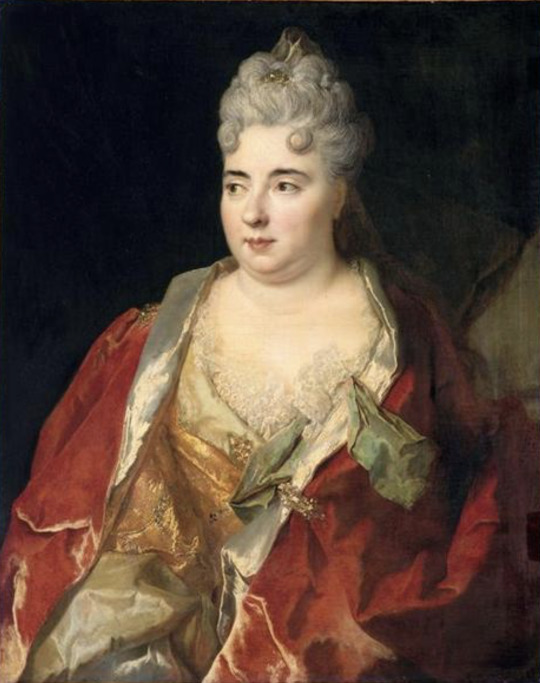



Late Louis XIV fashion: (from top to bottom) -
1690 Lady, three-quarter-length, in a blue dress with a red sash, with Cupid in a landscape by Claude Chapron (Bonhams - 6Jul01 auction Lot 143) 2652X3681 @150 2.4Mj.
ca. 1695 Marie Anne Mancini by Nicholas de Largillière (Musée du Louvre - Paris, France) photo - René-Gabriel Ojéda. From Base Joconde 1832X2316 @144 4.3Mj. She was one of the “Mazarinettes” that caused a sensation at Versailles a few decades earlier.
ca. 1718 Presumed portrait of Philippe, Duke of Orléans and Madame de Parabère by Pierre Gobert (attempted private auction by Sotheby's) 2867X2563 @72 1.4Mj.
Caroline of Ansbach, wife of George II by ? (location ?). From a-royal-obsession.tumblr.com/image/162994151687 1280X1539 @72 690kj. She was married to King George II and she worked with Horace Walpole to create the modern parliamentary form of government.
Lady, wearing a white and blue dress by Pierre Mignard (location ?). From tumblr.com/blog/view/roehenstart; erased spots & flaws w Pshop 966X1294 @72 275kj.
#late Louis XIV fashion#late Baroque fashion#1690s fashion#1690 fashion#1695 fashion#1710s fashion#Claude Chapron#curly hair#high coiffure#lace-edged chemise#U neckline#long sleeves#Marie Anne Mancini#Nicholas de Largillière#fripon curls#hair jewels#wrap#lining#Madame de Parabère#Pierre Gobert#hair flowers#cross over bodice#waist band#Caroline of Ansbach#Queen Caroline#quarter-length over-sleeves#elbow-length under-sleeves#clasps#Pierre Mignard#deep bateau neckline
19 notes
·
View notes
Text



Mademoiselle D'Armagnac by Antoine Trouvain, 1695
#1695#1690s#17th century#fashion plate#antoine trouvain#france#17th c. france#mdpillustration#illustration
78 notes
·
View notes